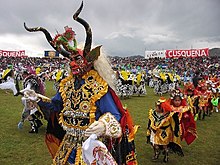68.100.209.15 (talk) No edit summary |
Unknown Lupus (talk | contribs) |
||
| Line 3: | Line 3: | ||
[[image:Diablada de La Tirana.jpg|thumb|''Diablada'' during the [[Fiesta de la Tirania]].]] |
[[image:Diablada de La Tirana.jpg|thumb|''Diablada'' during the [[Fiesta de la Tirania]].]] |
||
The '''Diablada''' is a [[South American]] [[dance]] that was created in the Andean [[Altiplano]] but holds [[auto sacramental]] origins in [[Spain]]. The dance is practised throughout the [[Andes|Andean region]], and is an important part of the cultural festivities of the |
The '''Diablada''' is a [[South American]] [[dance]] that was created in the Andean [[Altiplano]] but holds [[auto sacramental]] origins in [[Spain]]. The dance is practised throughout the [[Andes|Andean region]], and is an important part of the cultural festivities of the nations of [[Peru]], [[Bolivia]], and [[Chile]]. The dance stands prominent during the [[Diablada puneña|Fiesta de la Candelaria]] in Peru, the [[Carnaval de Oruro]] in Bolivia, and the [[Fiesta de la Tirana]] in Chile. However, the dance is also practiced in [[Venezuela]], [[Ecuador]] and [[Panama]]. |
||
The oldest ''Diablada'' is recorded to have taken place on [[Juli]], [[Puno]], in the area of present-day Peru. In the XVI century, [[Jesuit]] missionaries spread the ''[[autos sacramentales]]'', a dramatic representation of the mystery of the [[Eucharist]], in the [[Viceroyalty of Peru]], beginning in the city of [[Juli]]. During the evangelism of the native [[Lupacas]] people of Juli, the Jesuits made a representation of the [[seven deadly sins]] that concluded with the victory of the [[angel]], which represented good. Due to the mixture of cultures that took place in this city, it was known as the "little [[Rome]] of America" and the "[[Aymara]]'s Rome". |
|||
The oldest ''Diablada'' is recorded to have taken place on [[Oruro's carnival]] it's a huge parade that tells an story of the devils coming out of the mines and vow to the Virgin Mary. |
|||
The social facts that developed this dance are unique in the Bolivian environment, Bolivian highlands are very isolated and the population's distraction is to dance, there are other dances that follow the Diablada dance in [Oruro]'s carnival. |
The social facts that developed this dance are unique in the Bolivian environment, Bolivian highlands are very isolated and the population's distraction is to dance, there are other dances that follow the Diablada dance in [Oruro]'s carnival. |
||
Revision as of 20:41, 3 September 2009


The Diablada is a South American dance that was created in the Andean Altiplano but holds auto sacramental origins in Spain. The dance is practised throughout the Andean region, and is an important part of the cultural festivities of the nations of Peru, Bolivia, and Chile. The dance stands prominent during the Fiesta de la Candelaria in Peru, the Carnaval de Oruro in Bolivia, and the Fiesta de la Tirana in Chile. However, the dance is also practiced in Venezuela, Ecuador and Panama.
The oldest Diablada is recorded to have taken place on Juli, Puno, in the area of present-day Peru. In the XVI century, Jesuit missionaries spread the autos sacramentales, a dramatic representation of the mystery of the Eucharist, in the Viceroyalty of Peru, beginning in the city of Juli. During the evangelism of the native Lupacas people of Juli, the Jesuits made a representation of the seven deadly sins that concluded with the victory of the angel, which represented good. Due to the mixture of cultures that took place in this city, it was known as the "little Rome of America" and the "Aymara's Rome".
The social facts that developed this dance are unique in the Bolivian environment, Bolivian highlands are very isolated and the population's distraction is to dance, there are other dances that follow the Diablada dance in [Oruro]'s carnival.
The Diablada dance is a mix between European Catholicism and Bolivian social facts. As a landlocked nation, Bolivia is home of predominant authentic traditions.
The Social and Racial mix between Bolivian natives and Spanish Culture has lead the dance to develop such and amazing experience.
Miss universe dispute
In August 1 of 2009 Bolivian officials stated that it could present a legal appeal to the organizers of Miss Universe due to the planned use of a typical Diablada wear by the Peruvian candidate Karen Schwarz. Pablo Groux, Bolivian minister of Culture, said that any use of the wear by Scharwz in the content would be an unlawful appropriation of Bolivian heritage and have menaced to bring the case to the International Court of Justice. El Comercio, a Peruvian newspaper, have mentioned that this is not the first time the diablada wear is shown in the contest and that it was María Josefa Isensee, a Chilean, that first used it in the Miss Universe contest. Peruvian foreign minister José Antonio García Belaúnde said that since the Diablada dress is of indigenous Aymara origin it can not be considered an exclusive of any of the particular countries where the Aymara live.[1][2]